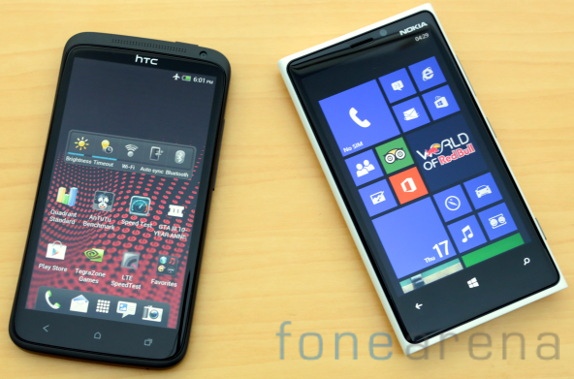
We’ve been doing the Nokia Lumia 920 vs the flagships series, and you could have seen the Nokia Lumia 920 vs Samsung Galaxy S3 comparison earlier. This time, it’s the Nokia Lumia 920 vs HTC One X. The HTC One X launched at the Mobile World Congress 2012 and was heralded as one of the most beautifully designed smartphones ever, while the Nokia Lumia 920, known for its own design too, was launched recently at Nokia World on the 5th of September. Both these devices share several traits and vie for the consumer’s wallets being placed in the same price bracket. So, which will come out on top? Lets see in the in depth comparison video below –
httpv://www.youtube.com/watch?v=njaAGTPbdl0
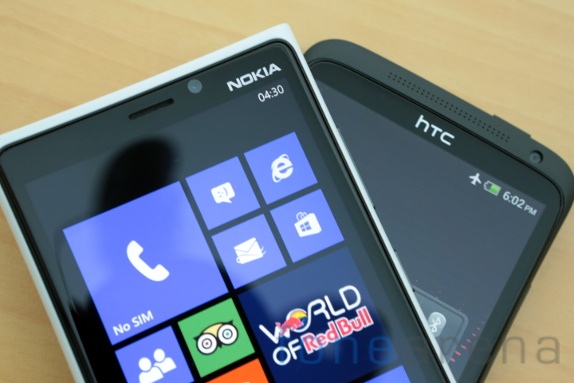
First up, we talk about the design, build quality and the ergonomics of both these devices. The HTC One X has a striking design and was one of the first phone to be a major departure from HTC’s previously bland design philosophy. The One X brought some curves back to the smartphone game and was widely regarded as one of the best designed smartphone devices ever made. The Nokia Lumia 920 on the other hand is based on the Nokia fabula design that was launched with the Nokia N9 and resembles more of the Nokia Lumia 800. Both the phones are made of single piece unibody polycarbonate, machined to accommodate the screen and the other components. Both the One X and the Lumia 920 are well built and well designed, but the differences arise only when we consider the ergonomics.
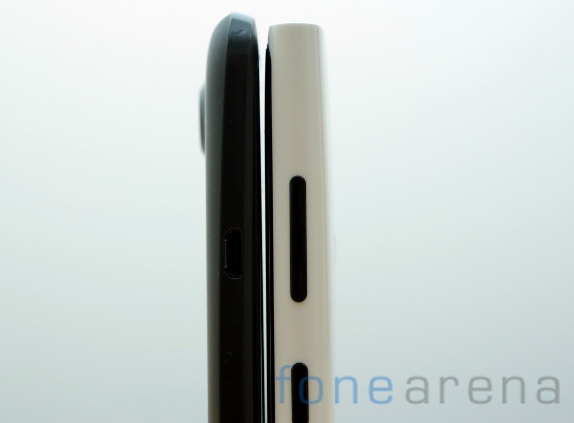
The One X comes at 8.9 mm thickness and weighs 130g while the Nokia Lumia 920 comes at 10.7mm thickness and weighs a whopping 185g. There is some justification to the weight as the phone packs a lot of technology, but feel wise, it’s not as sleek as the HTC One X and hence, even with a design flaw of the power button at the top of the device, the One X wins our favor in terms of design, build and more importantly ergonomics.
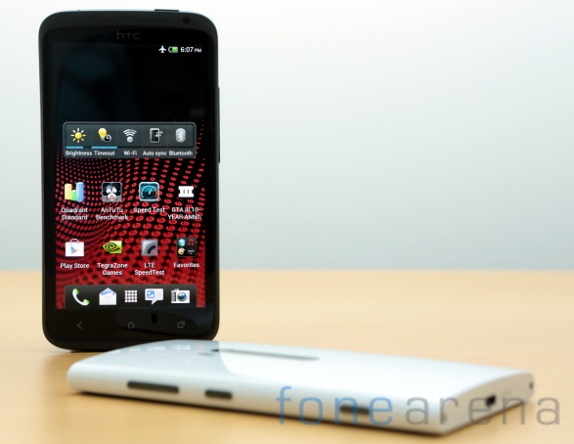
The display is an integral part of any smartphone and these two are no doubt among the best smartphone displays to have ever landed in the market. The One X has a 4.7 inch 16:9 1280×720 SLCD2 screen and was widely regarded as the best displays around the time it launched. The display is closely laminated to the screen and the striking colours and deep blacks are a great advantage to the One X’s interface. Likewise, the Lumia 920 has a 4.5 inch 16:10 15:9 1280×768 LCD screen with a ClearBlack polariser coating and a laminated screen. The colours are very rich and the pixel density a bit higher than the One X. The blacks are very deep and gel with the interface very well, making it impossible to differentiate with the black bezel. The display also packs a lot more features, like the PureMotion HD+ with 60Hz refresh rate that removes motion blur from the display, the software level sharpening along with CBD for outdoor visibility, the high sensitivity for usage with gloves and the new v2 oleo-phobic coating that massively reduces finger prints. There is just too many relevant features on the Lumia 920’s display that make the other displays look devoid of features. That way, the Lumia 920 easily wins out, for having one of the most versatile screens on any smartphone.
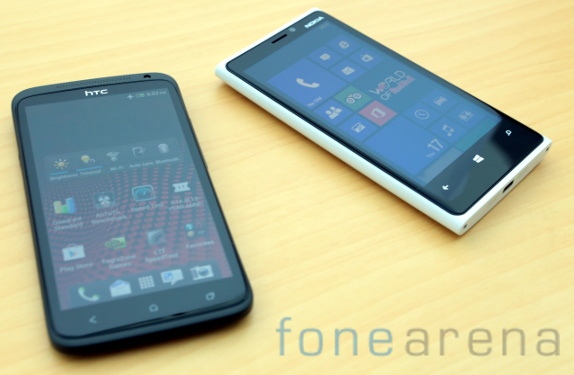
The internal hardware of these two devices are almost common except for the type of SoC used. The One X is a quad core 1.5 GHz Quad Core Nvidia Tegra 3 based phone with GeForce ULP graphics, while the Nokia Lumia 920 is a Dual core 1.5 GHz Qualcomm Snapdragon S4 Plus MSM8960 based phone with Adreno 225 graphics. The Tegra 3 has a companion core to offload unimportant work loads. We are not quite sure if that really works because the battery life seems to be terrible anyways. On paper, the Tegra 3 should be ideally better, with more cores at same frequency, but the Krait architecture on the MSM8960 performs well enough to even beat the Tegra 3 in some benchmarks. The gaming performance though, completely goes to the Tegra 3, which is far superior in terms of quality and performance at similar resolution. And to top it off, exclusive games on the Tegrazone are a bonus. But both phones are very similar when it comes to casual day to day performance and there is nothing much to complain, really. Since Android JellyBean, the OS has been free from the inherent lag that scarred the earlier versions.
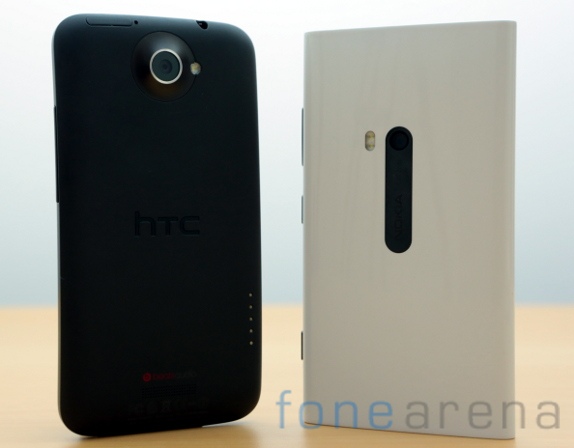
The cameras on both these phones are interesting. The One X was the first phone from HTC with a focus on the camera department making it somewhat special. The Image sense chip on the One X helps in a feature called Videopic, which means you can take a photo while recording a video simultaneously, and there was a lot of innovation with the interface too, which we much prefer over the bland Windows Phone camera interface. The camera is a 8 megapixel sensor with a f2.0 lens, supposedly letting you capture low light shots with ease, and there is software stabilisation for the video too. Good enough for a smartphone but the competition has proven to be better in our tests. The Galaxy S III and the iPhone 4S far outpace the One X in terms of camera performance and the Lumia 920 is no doubt ahead of the One X, with its PureView Optical image stabilisation for amazing low light performance in stills and non shaky video. The Lumia 920 has a f2.0 8.7 MP hybrid sensor and can record full HD 1080p video with HAAC mono audio.
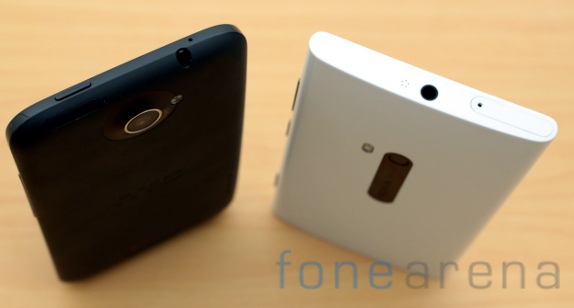
It is interesting to note that both these devices have some kind of audio enhancements built into them in terms of hardware as well as software. The One X has beats audio while the Nokia Lumia 920 has Dolby Stereo. Both can be added as an enhancement while playing audio through supported earphones/headphones/speakers. While we believe this feature might excite strict audiophiles, we feel it is of not much use to the casual user. But it exists and we can just acknowledge its presence, let alone compare it.
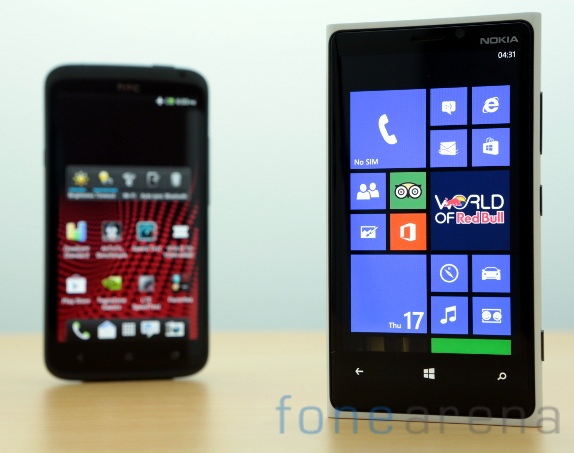
And finally we get to the software part. As we usually say, this part is highly subjective and it depends on the user and his/her choice of the operating system in question. The One X runs on Android 4.1.1 JellyBean and the Windows Phone 8 OS is the one powering the Nokia Lumia 920. The One X has its own HTC blessed skin over it called the Sense 4+, which tries to do away with the excessive bling associated with Sense. The Nokia on the other hand comes with lots of exclusive apps as the differentiator, with its sprawling choices for mapping solutions, camera related apps and OS utilities, it offers the best Windows Phone experience out of the box. The One X too has some exclusive apps, but they lack finesse and variety.
Android 4.1.1 comes with major improvements such as project butter and Google Now, which is Google’s own voice based artificial intelligence assistant that can help you in a predictive manner, and it massively improves with time. And since it is Android, you get a lot of apps and games, unlike the Windows Phone ecosystem, in which the lack of apps is now considered a major negative. However it is indeed catching up fast, with great quality third party apps but it’s the first party apps that matter and they are still nowhere to be seen, apart from very widely used service like Twitter and FourSquare and some more. For more in-depth OS level comparison, I suggest you watch the full video comparison above.
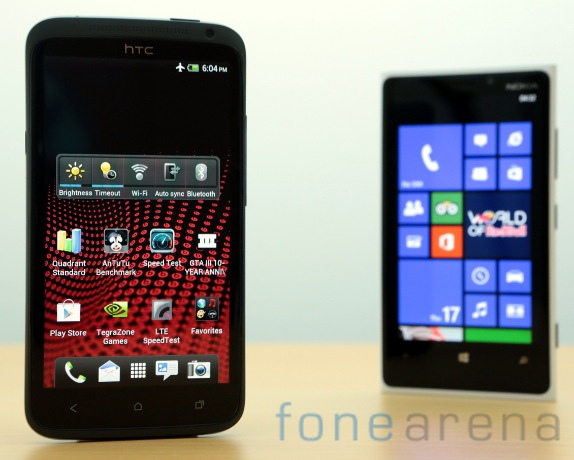
So, that’s all folks. The comparison ends here. Like in the video conclusion, I would like to say that the Nokia Lumia 920 and the HTC One X are very solid devices, each with their own advantages and disadvantages. In the end, it’s upto you to choose which goes best for you and your usage type. The One X might be good for people looking at a nice phone in the Android ecosystem, but only unless they don’t want the Galaxy S3 or other competing devices, but if you are looking at a top end Windows Phone, then the Lumia 920 is the phone to get.
With that said, all the above opinions are strictly ours and we would like to hear from you, on what device you think is the better of the two. So, do let us know your opinions in the comment section below!
